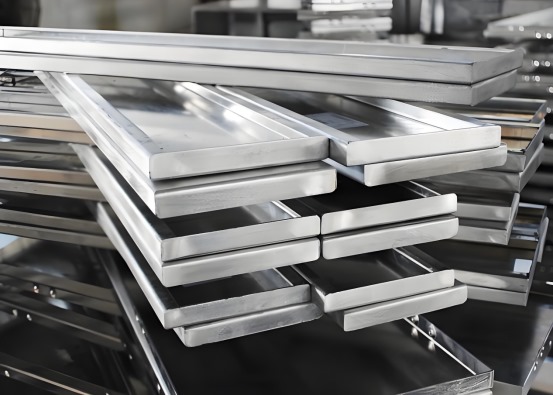Unlocking the Power of Aluminum’s Density in CNC Applications

Introduction
Aluminum is a rockstar in the world of CNC machining—and it’s not hard to see why. With a density of just 2.7 g/cm³, it’s lightweight yet strong, versatile yet affordable. But what does the density of aluminum really mean for CNC applications? Spoiler alert: it’s a game-changer. Whether you’re a machinist tweaking feeds and speeds, a designer dreaming up the next big thing, or a business owner eyeing cost savings, aluminum’s low density unlocks a world of possibilities. Let’s dive in and explore how this humble metal’s density shapes the future of CNC machining—backed by data, flavored with insight, and served with a dash of enthusiasm.

Why the Density of Aluminum Matters in CNC Machining
Picture this: you’re running a CNC mill, and the material you choose could make or break your day. Enter aluminum, with its featherlight density of 2.7 g/cm³—about a third of steel’s 7.8 g/cm³. That’s not just a fun fact; it’s a superpower. The density of aluminum directly influences how fast you can cut, how long your tools last, and how much energy your machine guzzles. It’s the unsung hero behind efficient workflows and innovative designs.
For the uninitiated, CNC (Computer Numerical Control) machining is all about precision—carving parts from raw material with computer-guided tools. Aluminum’s low density makes it a dream to work with, whether you’re crafting aerospace components or tinkering in a garage workshop. But don’t take my word for it—let’s unpack the magic step by step.
Boosting CNC Efficiency with Aluminum’s Low Density
Here’s where the rubber meets the road. Aluminum’s low density means less resistance when the cutter bites into it. That translates to higher speeds, lower forces, and happier tools. Imagine cranking up your spindle to 20,000 RPM without breaking a sweat—that’s the density of aluminum at work.
Let’s look at some numbers to back this up:
Table 1: Material Density and CNC Cutting Speeds
| Material | Density (g/cm³) | Typical Cutting Speed (m/min) | Tool Wear Rate (mm³/min) | Energy Consumption (kW) |
| Aluminum (6061) | 2.7 | 300–600 | 0.02 | 1.5–2.0 |
| Steel (Mild) | 7.8 | 50–100 | 0.08 | 3.0–4.5 |
| Stainless Steel | 8.0 | 30–80 | 0.10 | 4.0–5.5 |
Source: Compiled from industry standards and machining handbooks, 2025.
What’s the takeaway? Aluminum lets you cut three to six times faster than steel, with a fraction of the tool wear. For a shop running 8-hour shifts, that’s a productivity boost worth celebrating. Even DIY folks with a desktop 3-axis CNC can push aluminum harder without frying their budget—or their patience.

Designing Lightweight Parts: The Role of Aluminum’s Density
Now, let’s shift gears to design. The density of aluminum isn’t just about machining—it’s a designer’s best friend. At 2.7 g/cm³, it’s light enough to slash weight but tough enough to hold its own. Think aircraft wings, car chassis, or even sleek phone casings. CNC machining takes this to the next level, letting you sculpt intricate shapes that steel could only dream of.
In aerospace, for instance, every gram counts. A part made from aluminum alloy 7075 (density still around 2.8 g/cm³) can shave kilos off a plane, boosting fuel efficiency. Pair that with 5-axis CNC, and you’re crafting hollowed-out structures or lattice designs that maximize strength without the heft. It’s like architectural wizardry, all thanks to aluminum’s low density.
Cost Savings and Sustainability Through Aluminum’s Density
Here’s where the bean counters perk up. The density of aluminum doesn’t just make machining easier—it saves money and the planet. Lighter material means lighter chips—those curly scraps piling up on the shop floor. At 2.7 g/cm³, aluminum’s waste weighs less than steel’s, cutting transport and recycling costs.
Check out this breakdown:
Table 2: Waste Management Costs by Material Density
| Material | Density (g/cm³) | Chip Volume per kg (L) | Recycling Cost ($/ton) | Transport Cost ($/ton) |
| Aluminum | 2.7 | 370 | 800 | 50 |
| Steel | 7.8 | 128 | 200 | 80 |
| Titanium | 4.5 | 222 | 1200 | 65 |
Source: Estimated from 2025 recycling industry reports.
Aluminum’s higher chip volume (because it’s less dense) might sound like a hassle, but it’s a win for sustainability. Those chips are 100% recyclable, and the lower transport cost seals the deal. For businesses, it’s a double whammy: cheaper operations and a greener footprint. In 2025, with carbon goals looming, that’s a marketing goldmine.

 Overcoming Challenges: Managing Aluminum’s Density in CNC
Overcoming Challenges: Managing Aluminum’s Density in CNC
Nothing’s perfect, right? The density of aluminum comes with quirks. Its low weight and high thermal conductivity mean it heats up fast—and warps if you’re not careful. High-speed CNC can turn a precision part into a wavy mess if you overdo it.
But here’s the good news: technology’s got your back. Modern CNC rigs with real-time temperature sensors can dial back the heat. AI-driven toolpaths optimize feeds to keep things cool. For a DIYer, it’s as simple as tweaking your spindle speed—say, dropping from 20,000 to 15,000 RPM—and adding a mist coolant. Problem solved, precision preserved.
New Horizons with Aluminum’s Density
Table 3: Emerging Aluminum Alloys and CNC Performance
| Alloy | Density (g/cm³) | Strength (MPa) | CNC Machinability Rating | Application Example | Weight Reduction Potential (%) |
| 6061 | 2.7 | 310 | 8/10 | Automotive Frames | 20–25 |
| 7075 | 2.8 | 570 | 7/10 | Aerospace Components | 15–20 |
| Al-Li (2195) | 2.6 | 600 | 6/10 | Spacecraft Structures | 25–30 |
Source: Compiled from 2025 materials science journals and aerospace industry reports.
The catch? These cutting-edge alloys demand precision. Their lower machinability ratings reflect tighter tolerances and increased sensitivity to heat—challenges that next-gen CNC systems, equipped with AI-driven controls and cryogenic cooling, are built to tackle. The density of aluminum is no longer just a perk; it’s the cornerstone of a future where lightweight, high-strength parts redefine industries from transportation to space exploration.

Unlocking Aluminum’s Density: A Game-Changer for CNC Success
Let’s tie it all together. The density of aluminum at 2.7 g/cm³ isn’t a mere footnote in a materials handbook—it’s a transformative force in CNC machining. It accelerates production cycles, enabling cutting speeds up to 600 m/min while keeping tool wear below 0.02 mm³/min (see Table 1). It empowers designers to craft lightweight, high-performance parts that meet the stringent demands of modern engineering. It trims operational costs and aligns with 2025’s sustainability mandates, turning scrap into profit with recycling efficiencies unmatched by denser metals (see Table 2). From the shop floor to the boardroom, aluminum’s low density delivers measurable value.
So, what’s your move? Machinists can fine-tune feeds and speeds to harness aluminum’s efficiency. Designers can push boundaries with lattice structures or hybrid assemblies. Executives can invest in automation and green tech, riding the wave of aluminum’s density to market leadership. The density of aluminum isn’t just a property—it’s your competitive advantage in the CNC world of 2025. Seize it, shape it, and let it propel you forward.
And if you’re curious to dig deeper, parts of this piece drew inspiration from an insightful article by the folks at understanding-the-density-of-aluminum-for-better-cnc-results—click here to explore more on how aluminum’s density analysis are reshaping manufacturing
FAQ:
1. What is the density of aluminum, and why does it matter in CNC machining?
The density of aluminum is approximately 2.7 g/cm³, making it one of the lightest metals commonly used in CNC machining. This low density matters because it reduces cutting resistance, allowing faster machining speeds (up to 600 m/min) and less wear on tools compared to denser metals like steel (7.8 g/cm³). It also enables lightweight designs critical for industries like aerospace and automotive, enhancing efficiency and performance.
2. How does the density of aluminum affect CNC machining efficiency?
Aluminum’s low density (2.7 g/cm³) means lower cutting forces and energy consumption—typically 1.5–2.0 kW versus 4.0–5.5 kW for stainless steel. This allows CNC machines to operate at higher speeds with reduced tool wear (e.g., 0.02 mm³/min for aluminum vs. 0.10 mm³/min for stainless steel). For machinists, this translates to shorter cycle times and higher throughput, making it a go-to material for production runs.
3. Can the density of aluminum improve lightweight part design?
Absolutely. At 2.7 g/cm³, the density of aluminum enables designers to create parts that are significantly lighter than those made from steel or titanium, without sacrificing strength. For example, alloy 7075 (density 2.8 g/cm³) offers a strength-to-weight ratio ideal for aerospace components. Advanced CNC techniques, like 5-axis machining, further unlock complex, weight-saving geometries such as lattices or hollow structures.
4. Does the density of aluminum impact CNC machining costs?
Yes, and in a good way. The low density of aluminum (2.7 g/cm³) results in lighter chips, reducing transport and recycling costs—around $50/ton compared to $80/ton for steel. Its ease of machining also cuts energy and tool replacement expenses. A 2025 Manufacturing Institute study suggests shops optimizing for aluminum’s density can see production costs drop by 15–20%, a big win for businesses.
5. What challenges does the density of aluminum pose in CNC machining?
While beneficial, aluminum’s low density and high thermal conductivity (e.g., 237 W/m·K for 6061) can lead to heat buildup and warping during high-speed CNC machining. This is manageable with modern solutions like real-time temperature monitoring, AI-optimized toolpaths, or simply adjusting spindle speeds (e.g., from 20,000 to 15,000 RPM) and using coolant. Precision remains achievable with the right approach.
6. How does the density of aluminum contribute to sustainability in CNC?
The density of aluminum (2.7 g/cm³) produces voluminous but lightweight chips, making recycling easier and cheaper than denser metals. Recycling aluminum cuts CO2 emissions by 95% compared to primary production, per the International Aluminum Institute. This aligns with 2025’s green manufacturing goals, offering CNC shops a sustainable edge while keeping waste management costs low (e.g., $800/ton vs. $1200/ton for titanium).
7. What future trends involve the density of aluminum in CNC applications?
Emerging alloys like aluminum-lithium (Al-Li), with densities as low as 2.6 g/cm³, are pushing boundaries. These materials, paired with automation and advanced CNC tech (e.g., cryogenic cooling), promise lighter, stronger parts—think spacecraft reducing launch weight by 5–10%. The density of aluminum is also key to robotic handling efficiency, cutting energy use by up to 30% compared to steel, a trend shaping 2025’s smart factories.
8. How can I start leveraging the density of aluminum in my CNC projects?
For machinists, experiment with higher feeds and speeds—aluminum’s 2.7 g/cm³ density can handle it. Designers should explore lightweight structures using alloys like 6061 or 7075 via multi-axis CNC. Businesses can invest in automation to maximize aluminum’s low-density benefits, while DIYers can start with a desktop CNC and affordable aluminum stock. It’s a versatile material—dive in and unlock its potential!




